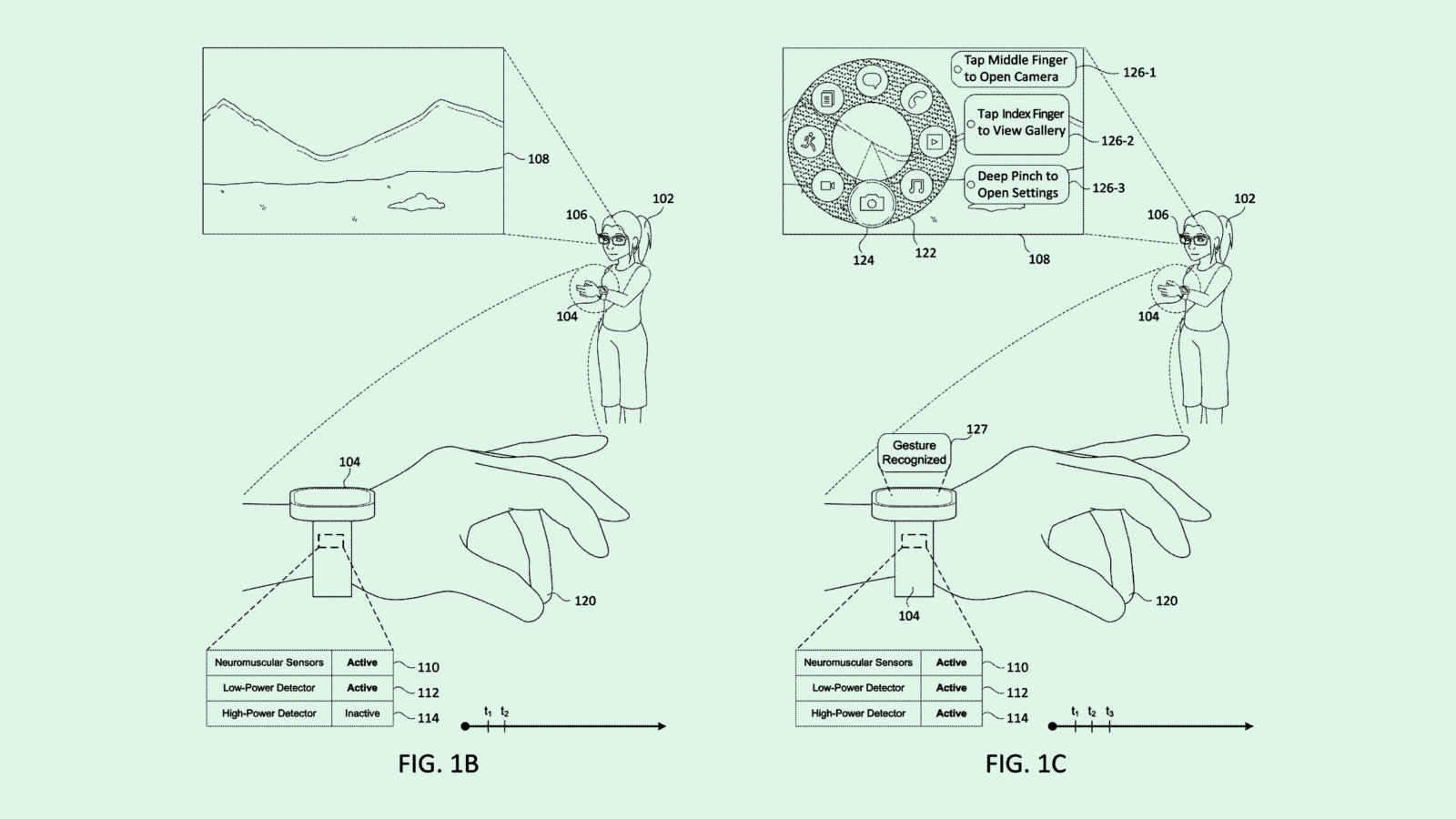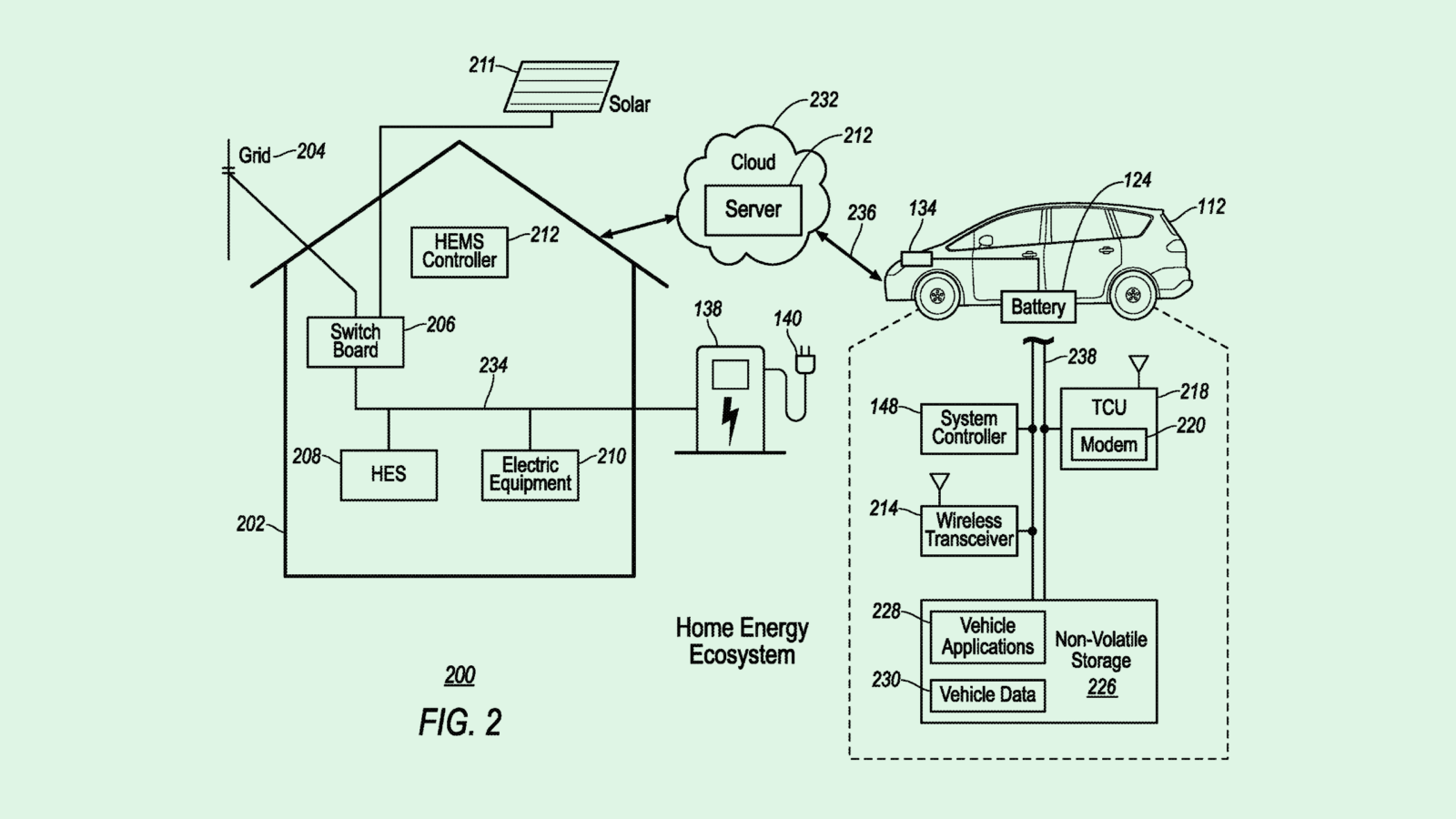Happy Thursday and welcome to Patent Drop!
Today, Meta’s plans to track your movements without draining power highlights that battery efficiency and form factor remain a major roadblock in artificial reality adoption. Plus: Ford wants to make EV charging cheaper and easier, and Google wants to turn search results into a back-and-forth.
Let’s take a peek.
Meta’s Power Play
Meta wants to be able to read your body language. Unfortunately, doing so takes more than a little bit of processing power.
Its recent patent may help solve this issue: the company filed an application for “power-efficient processing of neuromuscular signals” to track gestures. This tech uses a “lower-power detector” to distinguish gestures from one another, aiming to reduce misread signals without draining the battery.
“Power-efficiency needs can be particularly pronounced for new in-air hand gestures that can be detected based on neuromuscular signals, because … the machine-learning models used to process the neuromuscular signals can have high-power consumption requirements to operate,” Meta said in the filing.
Meta’s system first collects neuromuscular signals detected via a smartwatch, initially running those signals through the low-power detector. This uses machine learning to determine if a specific in-air hand gesture was performed with “precursor neuromuscular signals.”
If the low-power detector picks up a hand gesture, the high-power detector then kicks in. This sits in a “sleeping or waiting state” until needed to indicate exactly what gesture was performed. Once confirmed, the system would register the gesture, potentially activating a corresponding action.
If that gesture is performed again, only the low-power detector kicks in, saving the battery in the long run by not using the power-intense processor each time a user makes a certain gesture. Using a two-detector system to read the gestures initially also helps mitigate false positives.
Meta noted that this tech could work in tandem with artificial reality systems, allowing for accurate gesture recognition to control virtual, augmented, or mixed reality.

Plenty of tech firms have sought to patent body signal and gesture detection tech – Meta included. While it’s helpful for allowing users to control the world around them in artificial reality contexts, these systems are often embedded within the headsets themselves, giving off a lot of heat and driving up latency, said DJ Smith, co-founder and chief creative officer at The Glimpse Group. “It’s all just additional load that is put into the device,” he said.
Though tracking users’ hands with a headset itself – rather than with a “peripheral” device such as a smartwatch — is preferred for adoption in the long run, current technology is as convenient or accurate as it needs to be, he noted. Using a smartwatch could help alleviate that friction.
At its core, however, this patent addresses the power drain issue – one that’s long been an obstacle in artificial reality development. Meta’s roadmap relies on creating artificial reality headsets, specifically smart glasses that can be continuously worn all day, and used for hours at a time without needing to be charged. Another recent Meta patent highlighted this desire, signaling its research into smart glasses lasting 8 to 12 hours between charges.
But as it stands, these headsets can’t last more than a few hours without rapidly losing battery. Their large form factor, often weighed down by processing needs, also makes them less portable, said Smith. Adding a smartwatch into the mix may drive up the price, but it could significantly reduce necessary processing power on the headsets themselves – opening the door for lighter, more energy-efficient smart glasses.
“The next generation of this tech is trying to figure out how to … get these devices as small as possible,” said Smith.
While Meta chucked plans for its first smartwatch back at the end of 2022, plans for this tech bubbled up again in their roadmap revealed in early 2023. Plus, the company has sought to patent a smartwatch for tracking “physiological measurements” like motion, heart rate, and blood pressure. But Meta has some stiff competition in the watch market, chiefly from Apple, Smith noted.
“When I read this, I thought this was really directed at Apple and the direction that they would likely take with their own headset, watch, and ecosystem,” he said.
Ford’s DIY EVs
EV adoption has hit a wall. Ford is looking at ways to overcome one of its biggest hurdles: charging.
The automaker filed two patents to make at-home EV charging cheaper and easier. For starters, Ford is seeking to patent a system for controlling “vehicle and home energy storage systems.” This tech manages the charging of an EV to balance energy costs versus demand.
Ford’s system predicts when prices are going to hit a certain threshold, and charges a vehicle to a target point before then. During high-price periods, these vehicles can then discharge that energy back to the building to which it’s attached. This bidirectional system automates the process of cost-efficient charging, while simultaneously giving back to the home during peak hours at which energy usage is expensive.
Additionally, the company wants to patent a system for a “modular, upgradable EV charging ecosystem.” This patent application details a design for an EV charging system intended to be easily customizable and expandable, achieving this with swappable electrical current transformers and outlets that can be upgraded as technology advances.
Ford’s tech intends to make at-home charging easier to adopt, as well as help commercial customers expand more quickly and see quicker return on investment, the company noted. “Current charging stations are generally static and potentially incompatible with future technology,” the company said.

These patents add to several from the automaker seeking to make EV charging a little smarter. The company has previously sought patents for a charging scheduler based on demand, a system to prioritize charging vehicles when renewables are available, and a technique that allows vehicles to support homes during power outages.
Ford has long had ambitious EV goals, aiming to sell EVs at a run rate of 600,000 vehicles annually by this year, eventually pushing to 2 million globally. But as demand has started to drop, the company may have started to dim its expectations. In April, the company delayed production on its all-electric SUV and pickup truck. It also offered rebates and price cuts on its EV trucks to entice more customers.
And Ford isn’t the only company feeling the EV slump. Volvo cut funding to EV startup Polestar, and rental car company Hertz sold and paused purchases on thousands of EVs earlier this year. Earlier this week, Toyota, Mazda, and Subaru unveiled a new hybrid engine that can run on both hydrogen and gasoline.
One major reason for this may be consumer concerns about charging itself. According to a November survey of 7,500 consumers from S&P Global, while vehicle price stood out as the biggest concern, 44% reported concerns about charging availability. Plus, only 51% of EV owners surveyed had a charger installed in their home.
Tech like this that aims to make charging more seamless and adoptable could be a plan by Ford to help quell consumer worries and create ways to get more charging infrastructure in place if demand makes a comeback.
Google Takes Turns
Google may want its users to have a say in their search results.
The company is seeking to patent a system for “using user input to adapt search results” provided in an automated assistant context. Google’s system modifies search results based on user feedback in a turn-based conversation.
Many automated assistants lack the ability to adapt when presenting search results. These assistants often need to redo tasks when they get things wrong, eating up computational resources and making the user experience tedious, Google noted. This system aims to fix the existing constraints of an automated assistant presenting search results to users.
When a user asks the automated assistant to search for something, and the automated assistant presents options that aren’t suited to the user’s needs, the user would be allowed to respond with more detail on their requests. The assistant would then take those suggestions and modify the search results, in some examples using deep neural networks to get a better grasp on what the user is asking.
Within this context, Google’s assistant and the user could go back and forth until the user is satisfied with the results. Google noted that this could be operated through both spoken inputs and text inputs, such as a chatbot.
For example, if a user asks an automated assistant for “News on John Doe,” the system may pull up different headlines relating to that topic. The user could flip through these or request different headlines by saying or typing “next,” “more like this,” or any other input to give more detail.

Google is on a mission to embed AI into every part of its business – including its digital assistants. This patent adds to a pile of applications from Google that aim to make its assistants smarter, including multimodal and context-aware agents, as well as emotion-reading technology for smart speakers. The company added several new features to its AI assistant, called Gemini on Android, at its Google I/O conference earlier this month.
The new capabilities include integrating easy-to-use AI-generated images into Gmail, Google Messages, and other apps, adding AI-generated summaries to YouTube, and a paid feature that allows users to ask questions about documents. The company also debuted Gemini Live, allowing in-depth voice chats via phones.
Google’s search results got a makeover, too: The company started widely rolling out AI Overviews, its AI-generated summaries, to its search platform in mid-May. However, in several instances, it’s gotten things hilariously wrong due to hallucinations in which it understands misleading information or sarcasm as fact.
For example: When asked how many rocks a person should eat in a day, it recommended to one user to consume “at least one small rock per day,” referencing a 2021 article from The Onion. When another asked how to make cheese stay on pizza, it recommended adding non-toxic glue to the sauce, referencing a 2011 Reddit post.
However, because this patent deals directly with search, if it gets the same Gemini treatment that the rest of Google’s suite has gotten, the company may have to consider the fact that AI has a tendency to mess up.
Extra Drops
- Ford wants to take you off the beaten path. The automaker wants to patent tech for “off-road driving assistance.”
- IBM wants to keep you from hip-checking your kitchen table. The company filed a patent application for “collision prevention prioritization in extended reality.”
- Snap wants to make sure your smart glasses fit. The company filed a patent application for “strain gauge estimation” on the components.
What Else is New?
- Google will spend $2 billion to build data center infrastructure in Malaysia, creating the country’s first cloud region.
- Amazon cleared another FAA hurdle that allows its drones to fly farther distances, opening the door for it to expand its drone delivery service.
- Salesforce shares tumbled Thursday after the company’s earnings disappointed investors.
Patent Drop is written by Nat Rubio-Licht. You can find them on Twitter @natrubio__.
Patent Drop is a publication of The Daily Upside. For any questions or comments, feel free to contact us at patentdrop@thedailyupside.com.
